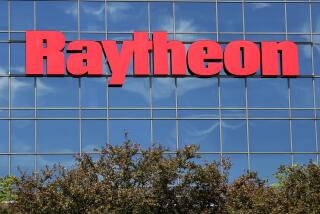Antimissile Test Report Faulted
- Share via
WASHINGTON — A team of defense contractors described a 1997 test of a key missile defense component as “excellent” and a “success,” even though the results indicated that the component had a variety of performance problems, congressional investigators reported Monday.
A General Accounting Office report said that officials from Boeing and TRW offered the upbeat assessment despite a flight test showing that their prototype antimissile “kill vehicle” had trouble finding its intended targets in space and couldn’t distinguish a mock warhead from decoys. The component also had problems with cooling, noise and calibration, the report said.
The report comes amid debate over whether the complex and costly antimissile system proposed by the Bush administration can be made to work. In January, the Congressional Budget Office put the ultimate cost of the program at between $23 billion and $68 billion or more, depending on the design. Critics of the missile defense program contended Monday that the GAO study should raise further questions about the program’s viability.
But the Pentagon and the defense contractors said the report was irrelevant because the Defense Department has since selected a different design for the system.
The June 1997 flight test became the subject of a series of official inquiries after a fired TRW engineer, Nira Schwartz of Torrance, sued the company. Her lawsuit included allegations that the company had faked work on the project to promote its product.
In its report, the GAO found no fraud and said that, taken together, the contractors’ reports to the Pentagon did convey the test results and the system’s limitations. But it faulted the contractors’ use of imprecise favorable language, saying that the use of subjective terms “increase the likelihood that test results would be interpreted in different ways, and might even be misunderstood.”
The kill vehicle is lofted into space atop an interceptor missile, where it is supposed to rely on a suite of sophisticated sensors to locate and destroy an incoming warhead.
In a joint effort, Boeing made the kill vehicle and sensor, while TRW wrote the computer programs designed to enable the system to differentiate the warhead from other objects. The Pentagon rejected the Boeing-TRW prototype in 1998 in favor of a competing model by Raytheon.
Air Force Lt. Col. Rick Lehner, a spokesman for the missile defense program, said the GAO’s findings had no bearing on the antimissile effort since the component “hasn’t been part of this program for more than four years.” He said the TRW-Boeing component differed from the component now in use in several ways, including the sensors, the discrimination system and the mathematical logic.
Lehner said that despite the TRW-Boeing kill vehicle’s problems, it did demonstrate that it had the fundamental capabilities required. Since it was the first flight test of the antimissile system, “you wouldn’t expect it all to be 100%. But it was on the right track.”
In a statement, TRW said the GAO report found that the company had “acted properly” and had “neither withheld or manipulated key data.”
The GAO found that in test reports presented in August 1997, the contractors cited only a few problems and called the sensor’s overall performance “excellent.”
Pentagon officials told GAO investigators that the contractors also reported orally to them at the time that there were more problems in performance. But there was no written evidence of such disclosures, the GAO found.
Later, in December 1997, after Schwartz had modified her lawsuit to include fraud allegations, Boeing and TRW made further disclosures. According to the report, they gave details of the sensor’s high-false alarm rate, the shortcomings of the discrimination software and other problems.
The companies disclosed additional information on the system’s weaknesses in a report in April 1998. All these reports together were enough to fully brief the Pentagon on the kill vehicle’s capabilities, the GAO said.
John Isaacs, president of Council for a Livable World, an arms control advocacy group, said that the report raises “further questions about whether missile defense can work effectively and consistently in realistic test conditions.”
“This is a more complex task than any other weapons program we’ve ever devised, and it has to be more effective,” he said.
More to Read
Sign up for Essential California
The most important California stories and recommendations in your inbox every morning.
You may occasionally receive promotional content from the Los Angeles Times.














